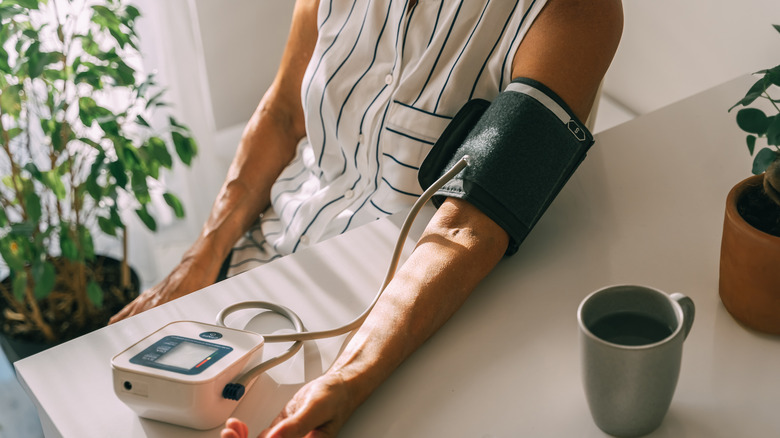The Arm Position That Can Falsely Raise Your Blood Pressure
Raise your hand if you want a better blood pressure rating. Just make sure you put it down the right way before your blood pressure is taken. Otherwise, your reading might make it seem as if your blood pressure is higher than it actually is.
Is this really a big deal? Yes, say the authors of a 2024 clinical trial (via JAMA Internal Medicine). The trial measured the blood pressure readings of individuals while their arms were in different positions. As it turns out, when participants rested their hands on their laps, their blood pressure numbers increased. The same phenomenon happened when they let their arms hang naturally by their sides.
The variations in blood pressure ranged from 4.0 to 10.0 millimeters of mercury (mmHg) and were significant enough for the researchers to suggest that the medical community get serious about emphasizing the need for the standardization of patients' arm placement when measuring blood pressure levels. Of course, that leads to the bigger question: Where should you put your arm to get the most accurate blood pressure reading?
Positioning your arm for accuracy
The next time you're checking your blood pressure at home or having it taken by a medical professional, keep your arm supported at heart level. This could mean having it rest on a desk or on a relatively high bedside table, chair, shelf, or tray. In this position, your heart doesn't have to work harder to circulate your blood, which should be reflected in more accurate blood pressure numbers.
To be fair, this isn't breaking news to members of the broader medical community. A 2017 article from the American Heart Association (AHA) addressed concerns over how unreliable blood pressure readings could be, even when the readings were performed by trained clinicians. The article outlined blood pressure reading best practices, including having a patient support his or her arm (and especially the cuffed area) on an apparatus parallel with the heart.
But why does having a slightly "off" blood pressure matter? Quite honestly, you could wind up being diagnosed with a condition you don't have. For example, if your true blood pressure reading is normal but on the cusp of being high, a slightly elevated reading could make it seem as if you had hypertension. In other words, you might then end up getting treated for something that's not a problem.
Habits that reveal your real blood pressure levels
Now that you know how to get a better blood pressure reading, you can put it into practice. However, even if your arm is in a perfect position, you could still wind up with an inaccurate blood pressure reading due to other factors.
For instance, your seated posture might be an issue. That's why the AHA reports that you should have your back supported and legs uncrossed while getting your blood pressure taken. Additionally, you should remain quiet during the procedure. Talking can make your blood pressure go up, according to WebMD. (And avoid emotionally heated conversations during the few minutes you're trying to get your blood pressure!) You also want to make sure your cuff is the correct size. As the Mayo Clinic notes, the wrong sized cuff can throw off your blood pressure readings. Fortunately, most medical professionals have a few cuffs to choose from, so they can get you the one that fits best.
It's probably worth mentioning that there's one situation where arm placement doesn't matter to blood pressure: space. If you're lucky enough to go into orbit, NASA insights reveal that what you do with your arms is unlikely to make a difference. In an anti-gravity situation, your whole cardiovascular system will be thrown off-kilter anyway. But when you return to your home planet, be sure to keep your arm and cuff at heart level for your next blood pressure appointment.


